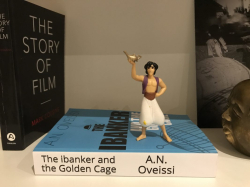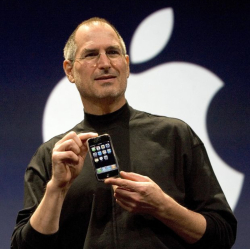 Jeff Bezos doesn’t really have over $100 billion, not in the way you may have $1,000 in a bank. Amazon.com isn’t worth $900 billion, in the way your house is worth $250,000.
Jeff Bezos doesn’t really have over $100 billion, not in the way you may have $1,000 in a bank. Amazon.com isn’t worth $900 billion, in the way your house is worth $250,000.
Both valuations are based on a lie, the idea that Bezos could sell out his stock, or that ready buyers would take out all shareholders at the current valuation. The value of a stock-based fortune, or a company’s market cap, is based on the price paid at the last trade.
So it is that we return to Aladdin’s Cave, which I wrote about in 2013.
Had Aladdin come out of that mythical cave, with all its gold and jewels, and tried to sell them, the value of gold and jewels in that town would have plummeted. He would have brought only a fraction of the value.
On the other hand, what if Aladdin were a Hamiltonian?
 In that case, he would have opened a bank, backed by the gold and jewels. He would have started making loans, based on the “capital” in this bank. This would have created new assets, in the form of loans on Aladdin’s bank, on which he might have made a market. The value of his balance sheet could have attracted investors, and as the loans paid off, they could have created new wealth, on which more loans could be capitalized.
In that case, he would have opened a bank, backed by the gold and jewels. He would have started making loans, based on the “capital” in this bank. This would have created new assets, in the form of loans on Aladdin’s bank, on which he might have made a market. The value of his balance sheet could have attracted investors, and as the loans paid off, they could have created new wealth, on which more loans could be capitalized.
This is how banking works.
The music stops when too many borrowers can’t pay back what they borrowed. Everything that spiraled up spirals down. It’s in balancing default risks that bankers make their money. The value of the bank is always conditional.
What does this have to do with Amazon and with government?
What Aladdin’s Bank, Amazon, and the government all depend upon to keep their game going is inflation. You don’t need much, but you always need some. Inflation keeps asset prices rising, ahead of the cost of loans, both principal and interest. Amazon is worth $900 billion because most investors think it will eventually be worth over $1 trillion. In the normal course of business, they would be right.
 But there’s something this analysis doesn’t account for, and I discussed it last week.
But there’s something this analysis doesn’t account for, and I discussed it last week.
It doesn’t account for deflation.
Technology creates a deflationary spiral whose power grows over time. That’s because 2×2 is 4, a gain of 2, while 2 million x 2 million, while also a doubling, is a gain of 2 million. In creating value, more work being done for less money, technology creates more and more deflation.
The benefits can be enormous, but because of how our system is set up these gains are going exclusively to stock investors, most especially to company founders, in the form of conditional value. The growing value of technology is being locked away in impregnable vaults, in stock values. As is true with Aladdin’s Cave, opening the vaults all at once – trying to sell out quickly – will destroy the value of what lies within.
The correct policy response to deflation is to spread wealth and spread risk. If more people are participating in economic growth, more money is spent and less locked away. Money needs to be recycled or it can’t do its job.
 This is what governments finally did in the 1930s, when manufacturing efficiency created a deflationary spiral. Hitler built bombs. Roosevelt built dams. After Roosevelt built bombs, we had the post-War era of shared prosperity into which I was born.
This is what governments finally did in the 1930s, when manufacturing efficiency created a deflationary spiral. Hitler built bombs. Roosevelt built dams. After Roosevelt built bombs, we had the post-War era of shared prosperity into which I was born.
This is doubly important when you understand the gating factor in economic growth today. It’s human capital. It’s measured not in bodies, but in human minds — active, engaged, educated minds. You can get them through education, you can import them, but to get the most out of them you need freedom. The best minds are free to go where they will. The greater your society’s liberty, the more attractive it becomes to free minds.
Given the lessons of history, and given Trump’s policies, the economy is headed for big trouble, and that right soon. Trump policies are directly opposed to free minds. He says we can’t import the people we need to compete. He supports religious fanatics who tell kids what to think. Most important, he’s blind to the threat of deflation.
The Trump Tax Cut went almost entirely into the stock market, into wealth with conditional value. All that money, $1 trillion per year, can disappear in a flash crash. Worse, it’s increasingly going into vaults. The fortunes of the fortunate have grown beyond their ability (or willingness) to recycle it.
 When the stock market next falls, wealth will disappear. But there will also be less money available to pay back the pile of debt we’ve just built. The only way out of that will be to print money, to debase the currency. That will destroy more wealth.
When the stock market next falls, wealth will disappear. But there will also be less money available to pay back the pile of debt we’ve just built. The only way out of that will be to print money, to debase the currency. That will destroy more wealth.
The correct economic policy for our time is to spread the wealth, to spend it, to recycle it, to invest it in human capital, the infrastructure we need for the challenges we’re ignoring.
The economics of Moore’s Law is clear. Liberal policies are better for business than conservative ones. But most people won’t recognize that until a lot of wealth has blown away.
This is the lesson of our time.










A very interesting read. Thanks.
A very interesting read. Thanks.